Management Accounting Systems and Costing Methods
VerifiedAdded on 2023/01/16
|15
|4196
|27
AI Summary
This document provides an overview of management accounting systems, including cost accounting, inventory management, and job costing systems. It also discusses the benefits of these systems and critically evaluates marginal and absorption costing methods. The document is relevant for students studying management accounting or related subjects.
Contribute Materials
Your contribution can guide someone’s learning journey. Share your
documents today.
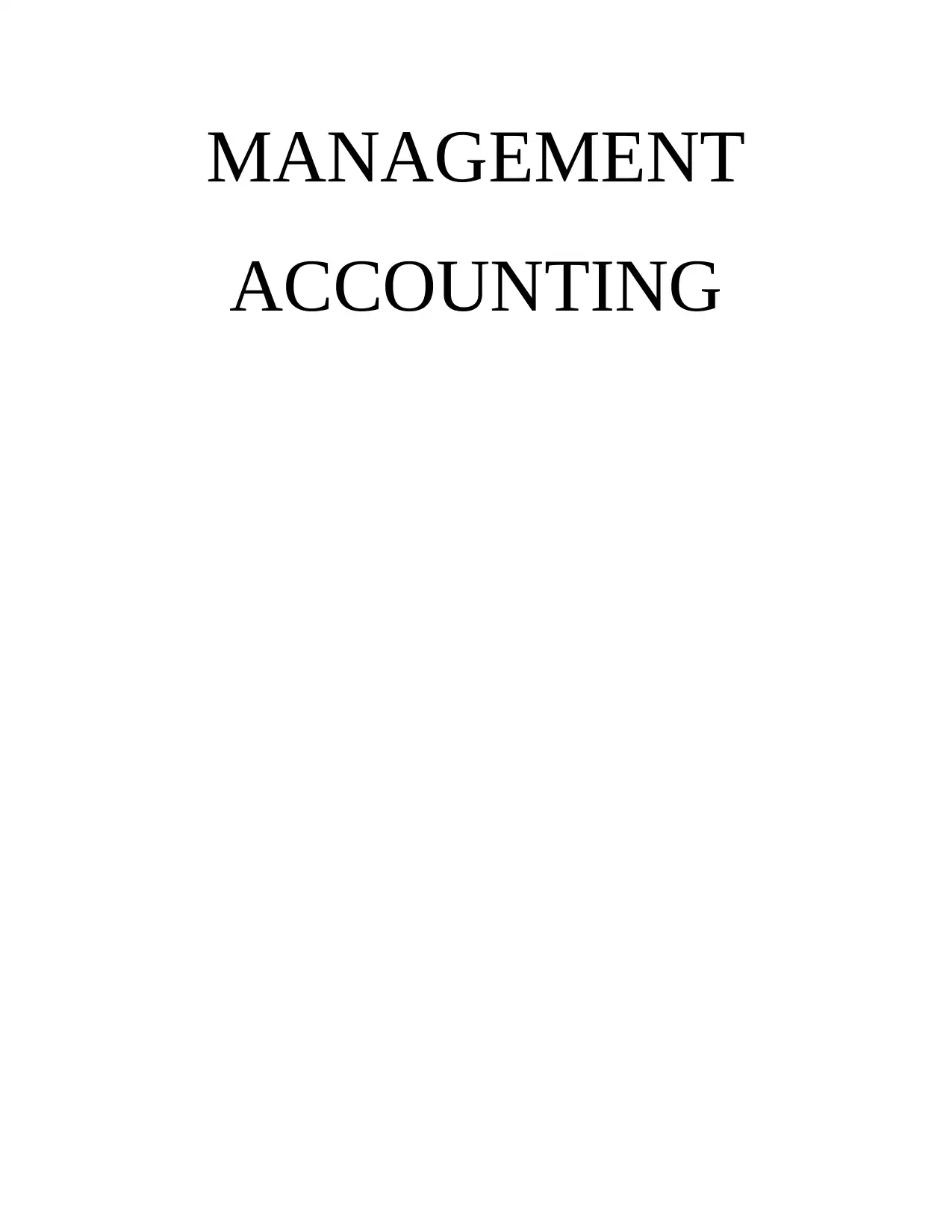
MANAGEMENT
ACCOUNTING
ACCOUNTING
Secure Best Marks with AI Grader
Need help grading? Try our AI Grader for instant feedback on your assignments.
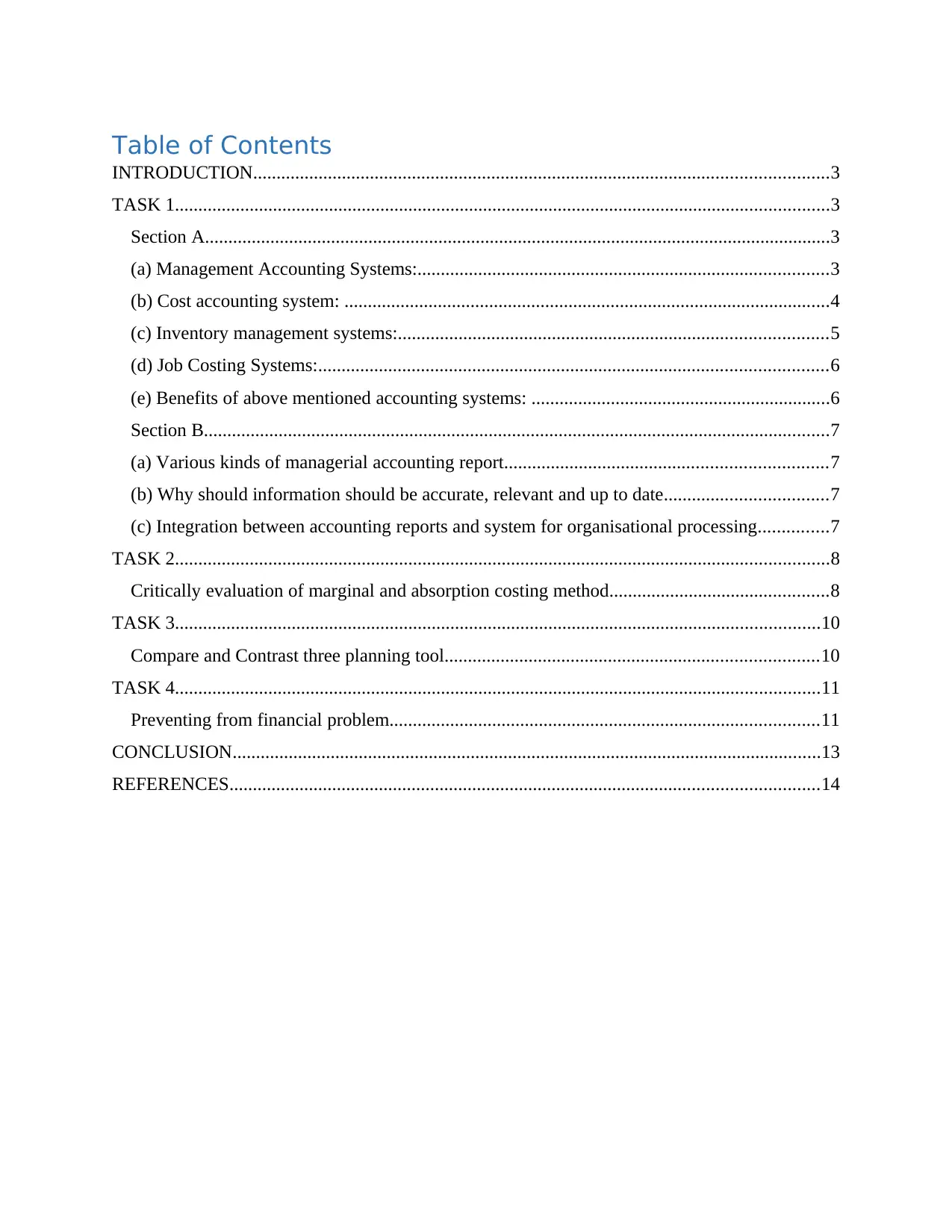
Table of Contents
INTRODUCTION...........................................................................................................................3
TASK 1............................................................................................................................................3
Section A......................................................................................................................................3
(a) Management Accounting Systems:........................................................................................3
(b) Cost accounting system: ........................................................................................................4
(c) Inventory management systems:............................................................................................5
(d) Job Costing Systems:.............................................................................................................6
(e) Benefits of above mentioned accounting systems: ................................................................6
Section B......................................................................................................................................7
(a) Various kinds of managerial accounting report.....................................................................7
(b) Why should information should be accurate, relevant and up to date...................................7
(c) Integration between accounting reports and system for organisational processing...............7
TASK 2............................................................................................................................................8
Critically evaluation of marginal and absorption costing method...............................................8
TASK 3..........................................................................................................................................10
Compare and Contrast three planning tool................................................................................10
TASK 4..........................................................................................................................................11
Preventing from financial problem............................................................................................11
CONCLUSION..............................................................................................................................13
REFERENCES..............................................................................................................................14
INTRODUCTION...........................................................................................................................3
TASK 1............................................................................................................................................3
Section A......................................................................................................................................3
(a) Management Accounting Systems:........................................................................................3
(b) Cost accounting system: ........................................................................................................4
(c) Inventory management systems:............................................................................................5
(d) Job Costing Systems:.............................................................................................................6
(e) Benefits of above mentioned accounting systems: ................................................................6
Section B......................................................................................................................................7
(a) Various kinds of managerial accounting report.....................................................................7
(b) Why should information should be accurate, relevant and up to date...................................7
(c) Integration between accounting reports and system for organisational processing...............7
TASK 2............................................................................................................................................8
Critically evaluation of marginal and absorption costing method...............................................8
TASK 3..........................................................................................................................................10
Compare and Contrast three planning tool................................................................................10
TASK 4..........................................................................................................................................11
Preventing from financial problem............................................................................................11
CONCLUSION..............................................................................................................................13
REFERENCES..............................................................................................................................14
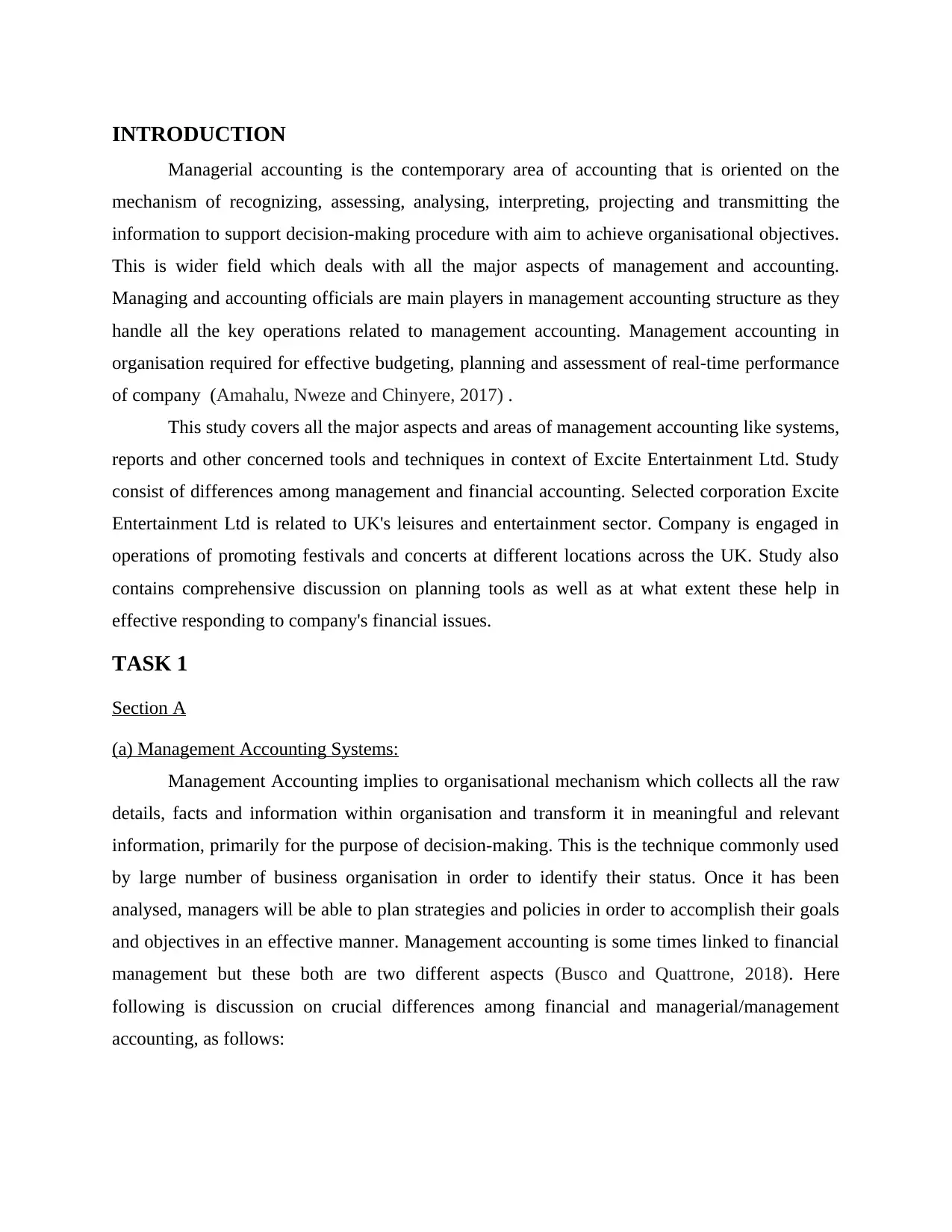
INTRODUCTION
Managerial accounting is the contemporary area of accounting that is oriented on the
mechanism of recognizing, assessing, analysing, interpreting, projecting and transmitting the
information to support decision-making procedure with aim to achieve organisational objectives.
This is wider field which deals with all the major aspects of management and accounting.
Managing and accounting officials are main players in management accounting structure as they
handle all the key operations related to management accounting. Management accounting in
organisation required for effective budgeting, planning and assessment of real-time performance
of company (Amahalu, Nweze and Chinyere, 2017) .
This study covers all the major aspects and areas of management accounting like systems,
reports and other concerned tools and techniques in context of Excite Entertainment Ltd. Study
consist of differences among management and financial accounting. Selected corporation Excite
Entertainment Ltd is related to UK's leisures and entertainment sector. Company is engaged in
operations of promoting festivals and concerts at different locations across the UK. Study also
contains comprehensive discussion on planning tools as well as at what extent these help in
effective responding to company's financial issues.
TASK 1
Section A
(a) Management Accounting Systems:
Management Accounting implies to organisational mechanism which collects all the raw
details, facts and information within organisation and transform it in meaningful and relevant
information, primarily for the purpose of decision-making. This is the technique commonly used
by large number of business organisation in order to identify their status. Once it has been
analysed, managers will be able to plan strategies and policies in order to accomplish their goals
and objectives in an effective manner. Management accounting is some times linked to financial
management but these both are two different aspects (Busco and Quattrone, 2018). Here
following is discussion on crucial differences among financial and managerial/management
accounting, as follows:
Managerial accounting is the contemporary area of accounting that is oriented on the
mechanism of recognizing, assessing, analysing, interpreting, projecting and transmitting the
information to support decision-making procedure with aim to achieve organisational objectives.
This is wider field which deals with all the major aspects of management and accounting.
Managing and accounting officials are main players in management accounting structure as they
handle all the key operations related to management accounting. Management accounting in
organisation required for effective budgeting, planning and assessment of real-time performance
of company (Amahalu, Nweze and Chinyere, 2017) .
This study covers all the major aspects and areas of management accounting like systems,
reports and other concerned tools and techniques in context of Excite Entertainment Ltd. Study
consist of differences among management and financial accounting. Selected corporation Excite
Entertainment Ltd is related to UK's leisures and entertainment sector. Company is engaged in
operations of promoting festivals and concerts at different locations across the UK. Study also
contains comprehensive discussion on planning tools as well as at what extent these help in
effective responding to company's financial issues.
TASK 1
Section A
(a) Management Accounting Systems:
Management Accounting implies to organisational mechanism which collects all the raw
details, facts and information within organisation and transform it in meaningful and relevant
information, primarily for the purpose of decision-making. This is the technique commonly used
by large number of business organisation in order to identify their status. Once it has been
analysed, managers will be able to plan strategies and policies in order to accomplish their goals
and objectives in an effective manner. Management accounting is some times linked to financial
management but these both are two different aspects (Busco and Quattrone, 2018). Here
following is discussion on crucial differences among financial and managerial/management
accounting, as follows:
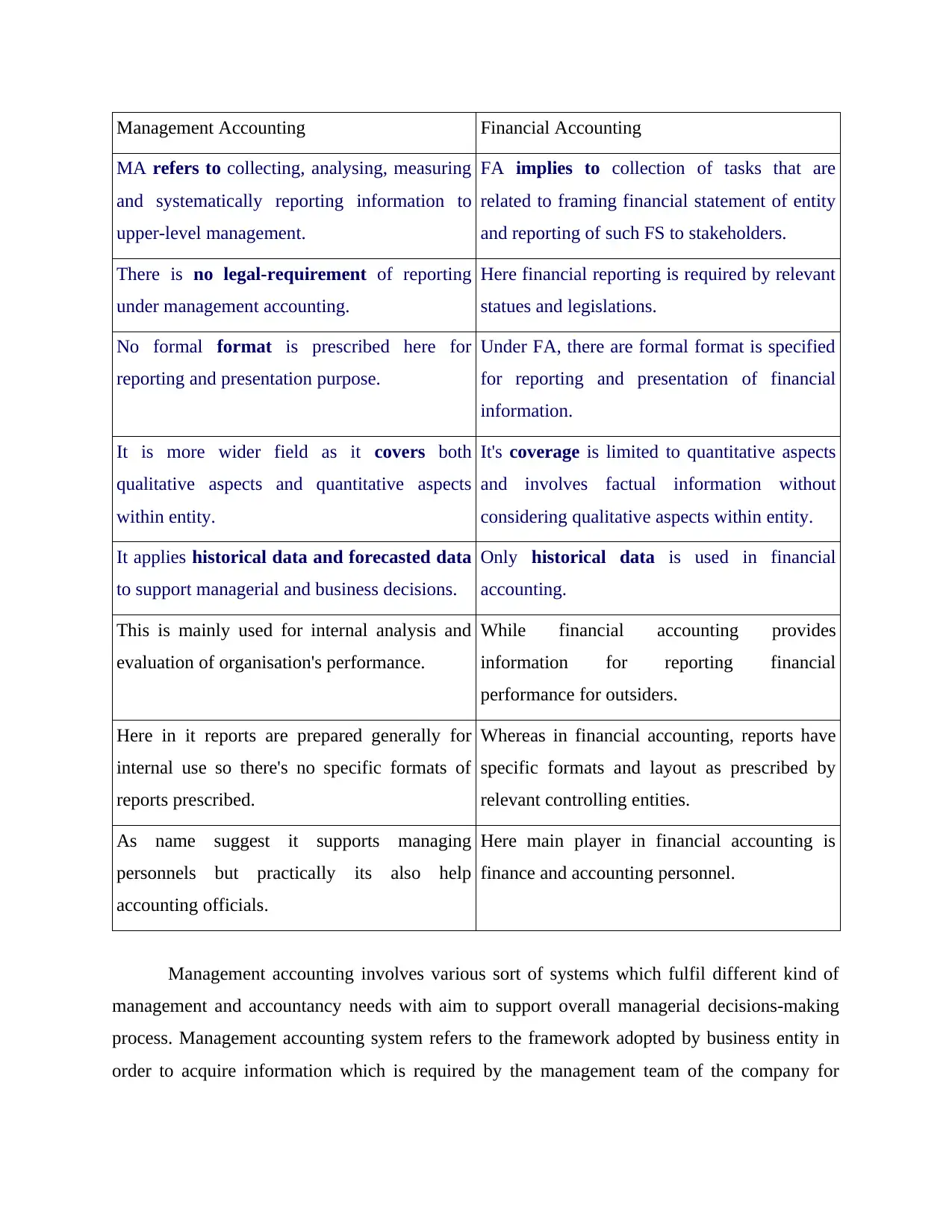
Management Accounting Financial Accounting
MA refers to collecting, analysing, measuring
and systematically reporting information to
upper-level management.
FA implies to collection of tasks that are
related to framing financial statement of entity
and reporting of such FS to stakeholders.
There is no legal-requirement of reporting
under management accounting.
Here financial reporting is required by relevant
statues and legislations.
No formal format is prescribed here for
reporting and presentation purpose.
Under FA, there are formal format is specified
for reporting and presentation of financial
information.
It is more wider field as it covers both
qualitative aspects and quantitative aspects
within entity.
It's coverage is limited to quantitative aspects
and involves factual information without
considering qualitative aspects within entity.
It applies historical data and forecasted data
to support managerial and business decisions.
Only historical data is used in financial
accounting.
This is mainly used for internal analysis and
evaluation of organisation's performance.
While financial accounting provides
information for reporting financial
performance for outsiders.
Here in it reports are prepared generally for
internal use so there's no specific formats of
reports prescribed.
Whereas in financial accounting, reports have
specific formats and layout as prescribed by
relevant controlling entities.
As name suggest it supports managing
personnels but practically its also help
accounting officials.
Here main player in financial accounting is
finance and accounting personnel.
Management accounting involves various sort of systems which fulfil different kind of
management and accountancy needs with aim to support overall managerial decisions-making
process. Management accounting system refers to the framework adopted by business entity in
order to acquire information which is required by the management team of the company for
MA refers to collecting, analysing, measuring
and systematically reporting information to
upper-level management.
FA implies to collection of tasks that are
related to framing financial statement of entity
and reporting of such FS to stakeholders.
There is no legal-requirement of reporting
under management accounting.
Here financial reporting is required by relevant
statues and legislations.
No formal format is prescribed here for
reporting and presentation purpose.
Under FA, there are formal format is specified
for reporting and presentation of financial
information.
It is more wider field as it covers both
qualitative aspects and quantitative aspects
within entity.
It's coverage is limited to quantitative aspects
and involves factual information without
considering qualitative aspects within entity.
It applies historical data and forecasted data
to support managerial and business decisions.
Only historical data is used in financial
accounting.
This is mainly used for internal analysis and
evaluation of organisation's performance.
While financial accounting provides
information for reporting financial
performance for outsiders.
Here in it reports are prepared generally for
internal use so there's no specific formats of
reports prescribed.
Whereas in financial accounting, reports have
specific formats and layout as prescribed by
relevant controlling entities.
As name suggest it supports managing
personnels but practically its also help
accounting officials.
Here main player in financial accounting is
finance and accounting personnel.
Management accounting involves various sort of systems which fulfil different kind of
management and accountancy needs with aim to support overall managerial decisions-making
process. Management accounting system refers to the framework adopted by business entity in
order to acquire information which is required by the management team of the company for
Secure Best Marks with AI Grader
Need help grading? Try our AI Grader for instant feedback on your assignments.
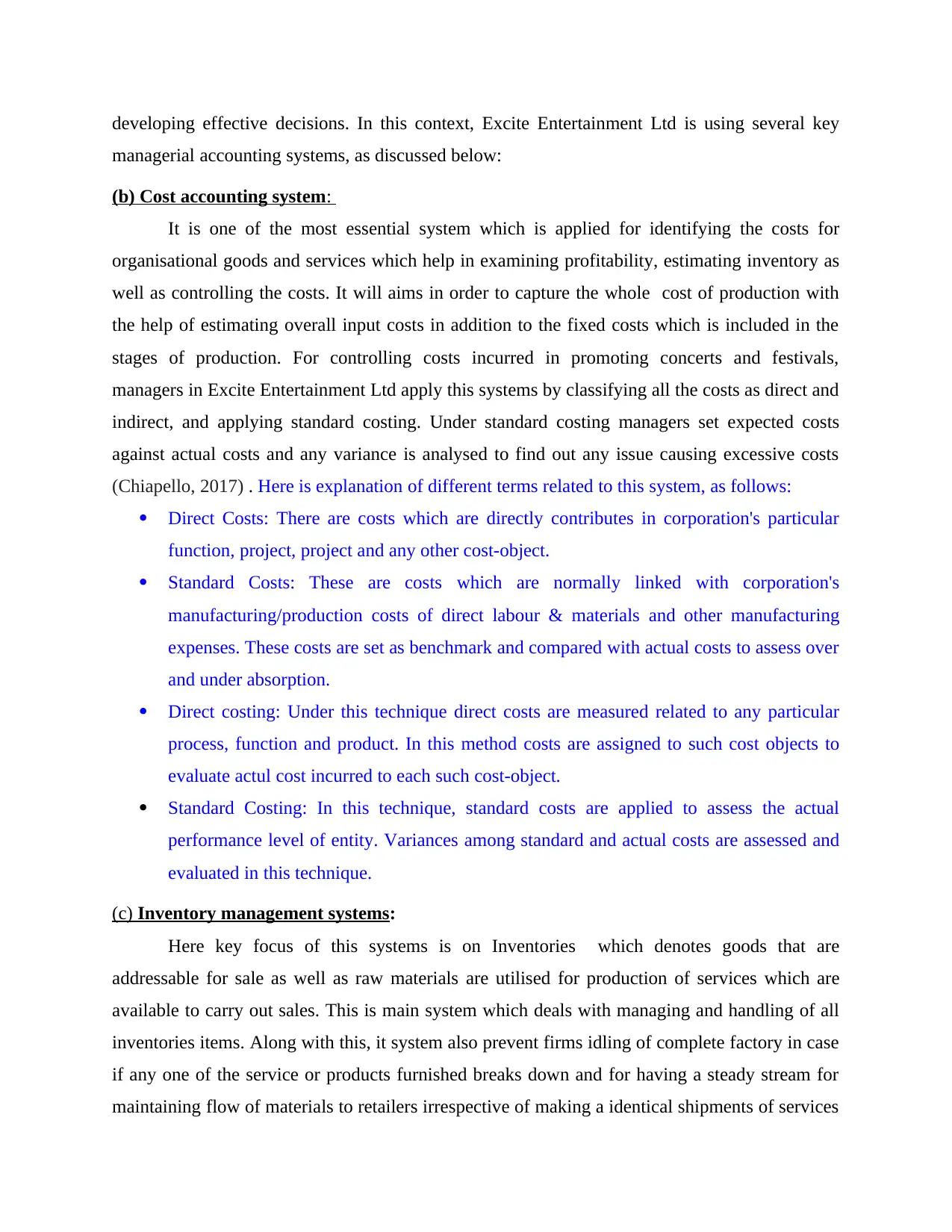
developing effective decisions. In this context, Excite Entertainment Ltd is using several key
managerial accounting systems, as discussed below:
(b) Cost accounting system:
It is one of the most essential system which is applied for identifying the costs for
organisational goods and services which help in examining profitability, estimating inventory as
well as controlling the costs. It will aims in order to capture the whole cost of production with
the help of estimating overall input costs in addition to the fixed costs which is included in the
stages of production. For controlling costs incurred in promoting concerts and festivals,
managers in Excite Entertainment Ltd apply this systems by classifying all the costs as direct and
indirect, and applying standard costing. Under standard costing managers set expected costs
against actual costs and any variance is analysed to find out any issue causing excessive costs
(Chiapello, 2017) . Here is explanation of different terms related to this system, as follows:
Direct Costs: There are costs which are directly contributes in corporation's particular
function, project, project and any other cost-object.
Standard Costs: These are costs which are normally linked with corporation's
manufacturing/production costs of direct labour & materials and other manufacturing
expenses. These costs are set as benchmark and compared with actual costs to assess over
and under absorption.
Direct costing: Under this technique direct costs are measured related to any particular
process, function and product. In this method costs are assigned to such cost objects to
evaluate actul cost incurred to each such cost-object.
Standard Costing: In this technique, standard costs are applied to assess the actual
performance level of entity. Variances among standard and actual costs are assessed and
evaluated in this technique.
(c) Inventory management systems:
Here key focus of this systems is on Inventories which denotes goods that are
addressable for sale as well as raw materials are utilised for production of services which are
available to carry out sales. This is main system which deals with managing and handling of all
inventories items. Along with this, it system also prevent firms idling of complete factory in case
if any one of the service or products furnished breaks down and for having a steady stream for
maintaining flow of materials to retailers irrespective of making a identical shipments of services
managerial accounting systems, as discussed below:
(b) Cost accounting system:
It is one of the most essential system which is applied for identifying the costs for
organisational goods and services which help in examining profitability, estimating inventory as
well as controlling the costs. It will aims in order to capture the whole cost of production with
the help of estimating overall input costs in addition to the fixed costs which is included in the
stages of production. For controlling costs incurred in promoting concerts and festivals,
managers in Excite Entertainment Ltd apply this systems by classifying all the costs as direct and
indirect, and applying standard costing. Under standard costing managers set expected costs
against actual costs and any variance is analysed to find out any issue causing excessive costs
(Chiapello, 2017) . Here is explanation of different terms related to this system, as follows:
Direct Costs: There are costs which are directly contributes in corporation's particular
function, project, project and any other cost-object.
Standard Costs: These are costs which are normally linked with corporation's
manufacturing/production costs of direct labour & materials and other manufacturing
expenses. These costs are set as benchmark and compared with actual costs to assess over
and under absorption.
Direct costing: Under this technique direct costs are measured related to any particular
process, function and product. In this method costs are assigned to such cost objects to
evaluate actul cost incurred to each such cost-object.
Standard Costing: In this technique, standard costs are applied to assess the actual
performance level of entity. Variances among standard and actual costs are assessed and
evaluated in this technique.
(c) Inventory management systems:
Here key focus of this systems is on Inventories which denotes goods that are
addressable for sale as well as raw materials are utilised for production of services which are
available to carry out sales. This is main system which deals with managing and handling of all
inventories items. Along with this, it system also prevent firms idling of complete factory in case
if any one of the service or products furnished breaks down and for having a steady stream for
maintaining flow of materials to retailers irrespective of making a identical shipments of services
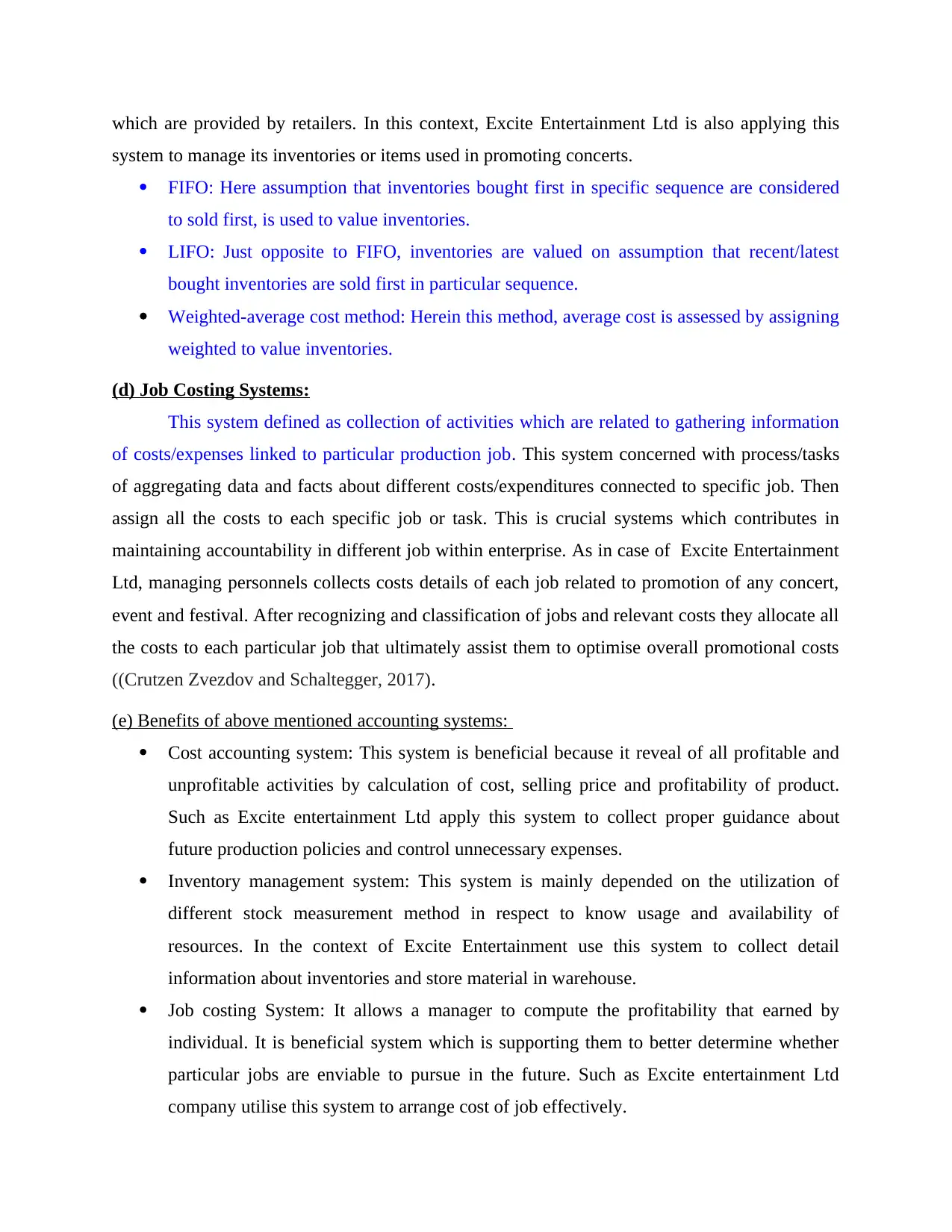
which are provided by retailers. In this context, Excite Entertainment Ltd is also applying this
system to manage its inventories or items used in promoting concerts.
FIFO: Here assumption that inventories bought first in specific sequence are considered
to sold first, is used to value inventories.
LIFO: Just opposite to FIFO, inventories are valued on assumption that recent/latest
bought inventories are sold first in particular sequence.
Weighted-average cost method: Herein this method, average cost is assessed by assigning
weighted to value inventories.
(d) Job Costing Systems:
This system defined as collection of activities which are related to gathering information
of costs/expenses linked to particular production job. This system concerned with process/tasks
of aggregating data and facts about different costs/expenditures connected to specific job. Then
assign all the costs to each specific job or task. This is crucial systems which contributes in
maintaining accountability in different job within enterprise. As in case of Excite Entertainment
Ltd, managing personnels collects costs details of each job related to promotion of any concert,
event and festival. After recognizing and classification of jobs and relevant costs they allocate all
the costs to each particular job that ultimately assist them to optimise overall promotional costs
((Crutzen Zvezdov and Schaltegger, 2017).
(e) Benefits of above mentioned accounting systems:
Cost accounting system: This system is beneficial because it reveal of all profitable and
unprofitable activities by calculation of cost, selling price and profitability of product.
Such as Excite entertainment Ltd apply this system to collect proper guidance about
future production policies and control unnecessary expenses.
Inventory management system: This system is mainly depended on the utilization of
different stock measurement method in respect to know usage and availability of
resources. In the context of Excite Entertainment use this system to collect detail
information about inventories and store material in warehouse.
Job costing System: It allows a manager to compute the profitability that earned by
individual. It is beneficial system which is supporting them to better determine whether
particular jobs are enviable to pursue in the future. Such as Excite entertainment Ltd
company utilise this system to arrange cost of job effectively.
system to manage its inventories or items used in promoting concerts.
FIFO: Here assumption that inventories bought first in specific sequence are considered
to sold first, is used to value inventories.
LIFO: Just opposite to FIFO, inventories are valued on assumption that recent/latest
bought inventories are sold first in particular sequence.
Weighted-average cost method: Herein this method, average cost is assessed by assigning
weighted to value inventories.
(d) Job Costing Systems:
This system defined as collection of activities which are related to gathering information
of costs/expenses linked to particular production job. This system concerned with process/tasks
of aggregating data and facts about different costs/expenditures connected to specific job. Then
assign all the costs to each specific job or task. This is crucial systems which contributes in
maintaining accountability in different job within enterprise. As in case of Excite Entertainment
Ltd, managing personnels collects costs details of each job related to promotion of any concert,
event and festival. After recognizing and classification of jobs and relevant costs they allocate all
the costs to each particular job that ultimately assist them to optimise overall promotional costs
((Crutzen Zvezdov and Schaltegger, 2017).
(e) Benefits of above mentioned accounting systems:
Cost accounting system: This system is beneficial because it reveal of all profitable and
unprofitable activities by calculation of cost, selling price and profitability of product.
Such as Excite entertainment Ltd apply this system to collect proper guidance about
future production policies and control unnecessary expenses.
Inventory management system: This system is mainly depended on the utilization of
different stock measurement method in respect to know usage and availability of
resources. In the context of Excite Entertainment use this system to collect detail
information about inventories and store material in warehouse.
Job costing System: It allows a manager to compute the profitability that earned by
individual. It is beneficial system which is supporting them to better determine whether
particular jobs are enviable to pursue in the future. Such as Excite entertainment Ltd
company utilise this system to arrange cost of job effectively.
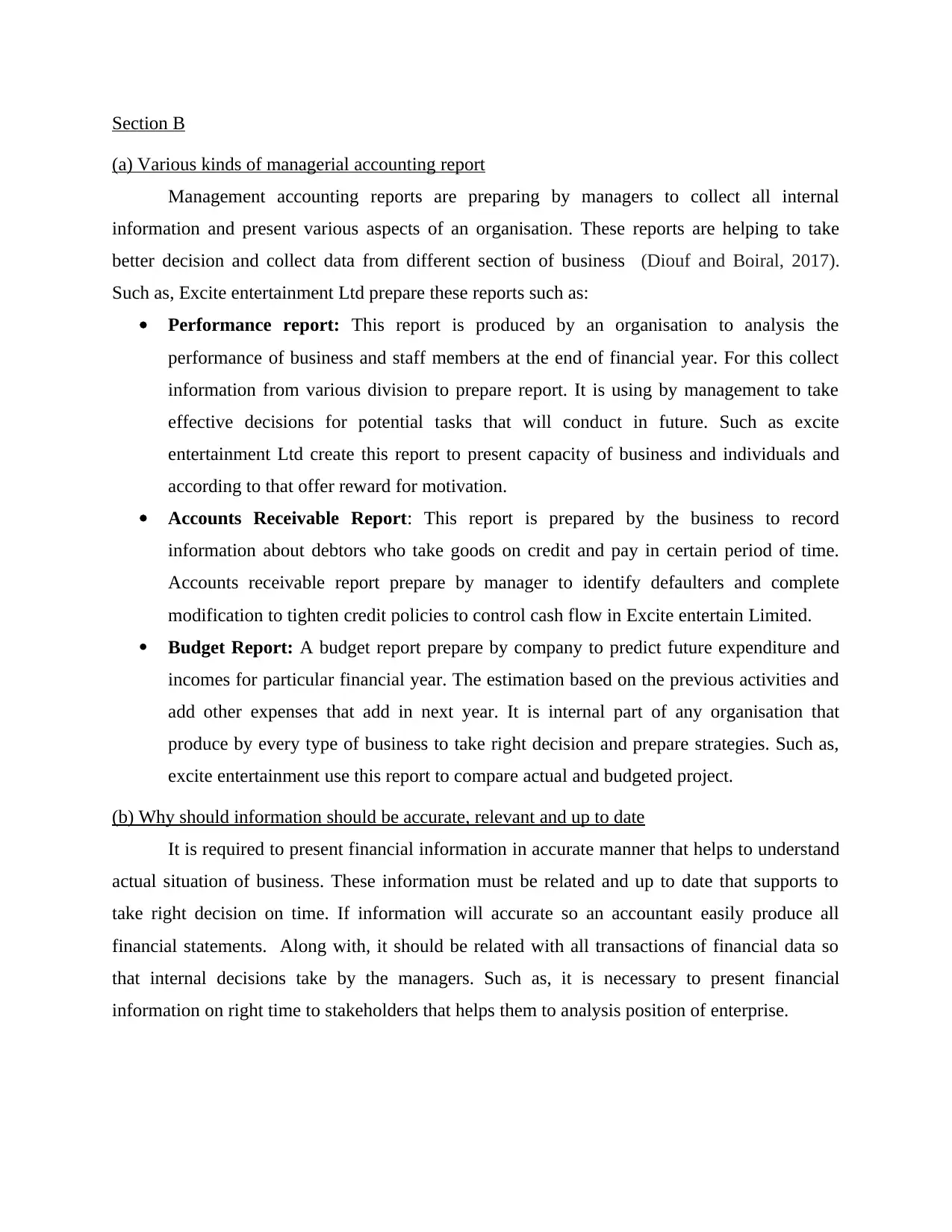
Section B
(a) Various kinds of managerial accounting report
Management accounting reports are preparing by managers to collect all internal
information and present various aspects of an organisation. These reports are helping to take
better decision and collect data from different section of business (Diouf and Boiral, 2017).
Such as, Excite entertainment Ltd prepare these reports such as:
Performance report: This report is produced by an organisation to analysis the
performance of business and staff members at the end of financial year. For this collect
information from various division to prepare report. It is using by management to take
effective decisions for potential tasks that will conduct in future. Such as excite
entertainment Ltd create this report to present capacity of business and individuals and
according to that offer reward for motivation.
Accounts Receivable Report: This report is prepared by the business to record
information about debtors who take goods on credit and pay in certain period of time.
Accounts receivable report prepare by manager to identify defaulters and complete
modification to tighten credit policies to control cash flow in Excite entertain Limited.
Budget Report: A budget report prepare by company to predict future expenditure and
incomes for particular financial year. The estimation based on the previous activities and
add other expenses that add in next year. It is internal part of any organisation that
produce by every type of business to take right decision and prepare strategies. Such as,
excite entertainment use this report to compare actual and budgeted project.
(b) Why should information should be accurate, relevant and up to date
It is required to present financial information in accurate manner that helps to understand
actual situation of business. These information must be related and up to date that supports to
take right decision on time. If information will accurate so an accountant easily produce all
financial statements. Along with, it should be related with all transactions of financial data so
that internal decisions take by the managers. Such as, it is necessary to present financial
information on right time to stakeholders that helps them to analysis position of enterprise.
(a) Various kinds of managerial accounting report
Management accounting reports are preparing by managers to collect all internal
information and present various aspects of an organisation. These reports are helping to take
better decision and collect data from different section of business (Diouf and Boiral, 2017).
Such as, Excite entertainment Ltd prepare these reports such as:
Performance report: This report is produced by an organisation to analysis the
performance of business and staff members at the end of financial year. For this collect
information from various division to prepare report. It is using by management to take
effective decisions for potential tasks that will conduct in future. Such as excite
entertainment Ltd create this report to present capacity of business and individuals and
according to that offer reward for motivation.
Accounts Receivable Report: This report is prepared by the business to record
information about debtors who take goods on credit and pay in certain period of time.
Accounts receivable report prepare by manager to identify defaulters and complete
modification to tighten credit policies to control cash flow in Excite entertain Limited.
Budget Report: A budget report prepare by company to predict future expenditure and
incomes for particular financial year. The estimation based on the previous activities and
add other expenses that add in next year. It is internal part of any organisation that
produce by every type of business to take right decision and prepare strategies. Such as,
excite entertainment use this report to compare actual and budgeted project.
(b) Why should information should be accurate, relevant and up to date
It is required to present financial information in accurate manner that helps to understand
actual situation of business. These information must be related and up to date that supports to
take right decision on time. If information will accurate so an accountant easily produce all
financial statements. Along with, it should be related with all transactions of financial data so
that internal decisions take by the managers. Such as, it is necessary to present financial
information on right time to stakeholders that helps them to analysis position of enterprise.
Paraphrase This Document
Need a fresh take? Get an instant paraphrase of this document with our AI Paraphraser
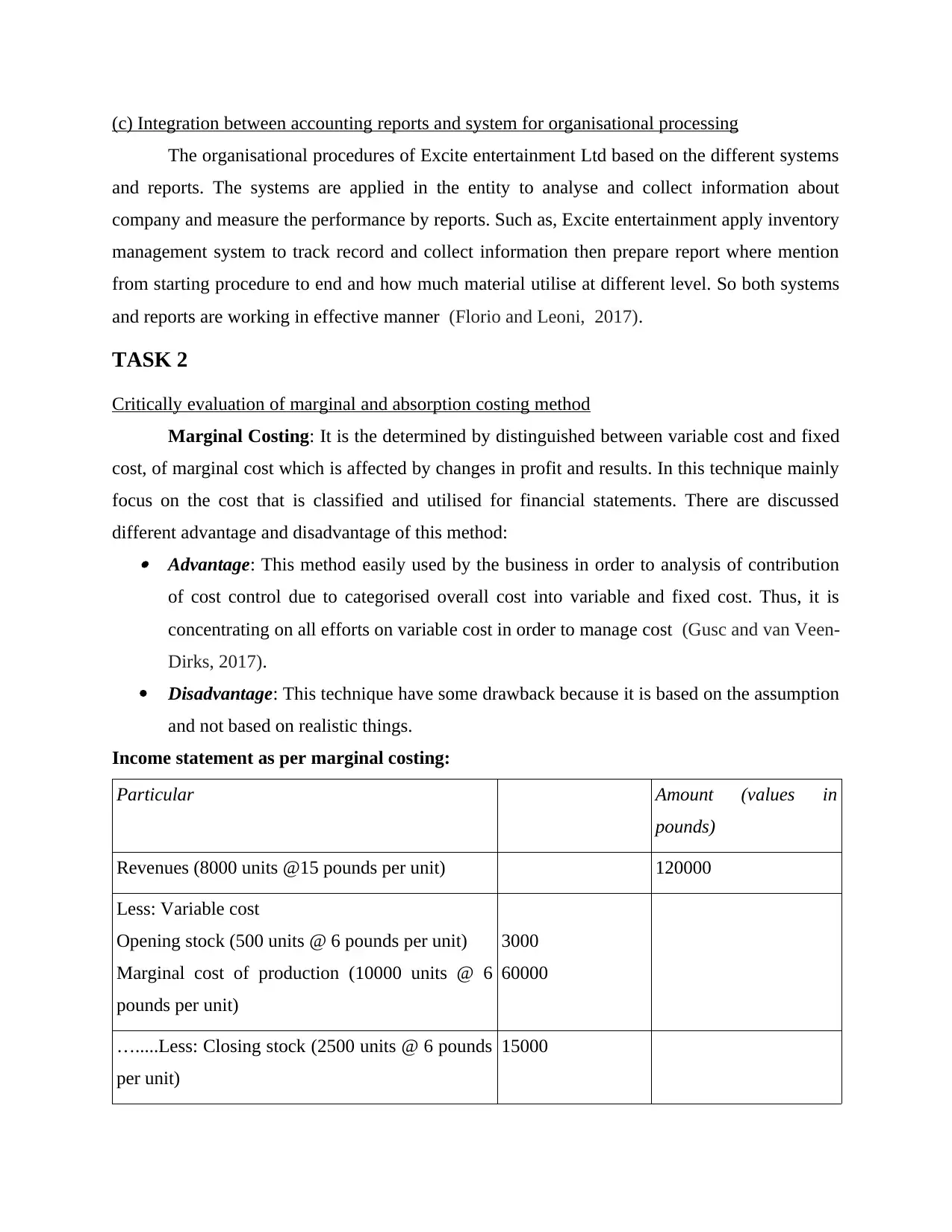
(c) Integration between accounting reports and system for organisational processing
The organisational procedures of Excite entertainment Ltd based on the different systems
and reports. The systems are applied in the entity to analyse and collect information about
company and measure the performance by reports. Such as, Excite entertainment apply inventory
management system to track record and collect information then prepare report where mention
from starting procedure to end and how much material utilise at different level. So both systems
and reports are working in effective manner (Florio and Leoni, 2017).
TASK 2
Critically evaluation of marginal and absorption costing method
Marginal Costing: It is the determined by distinguished between variable cost and fixed
cost, of marginal cost which is affected by changes in profit and results. In this technique mainly
focus on the cost that is classified and utilised for financial statements. There are discussed
different advantage and disadvantage of this method: Advantage: This method easily used by the business in order to analysis of contribution
of cost control due to categorised overall cost into variable and fixed cost. Thus, it is
concentrating on all efforts on variable cost in order to manage cost (Gusc and van Veen-
Dirks, 2017).
Disadvantage: This technique have some drawback because it is based on the assumption
and not based on realistic things.
Income statement as per marginal costing:
Particular Amount (values in
pounds)
Revenues (8000 units @15 pounds per unit) 120000
Less: Variable cost
Opening stock (500 units @ 6 pounds per unit)
Marginal cost of production (10000 units @ 6
pounds per unit)
3000
60000
….....Less: Closing stock (2500 units @ 6 pounds
per unit)
15000
The organisational procedures of Excite entertainment Ltd based on the different systems
and reports. The systems are applied in the entity to analyse and collect information about
company and measure the performance by reports. Such as, Excite entertainment apply inventory
management system to track record and collect information then prepare report where mention
from starting procedure to end and how much material utilise at different level. So both systems
and reports are working in effective manner (Florio and Leoni, 2017).
TASK 2
Critically evaluation of marginal and absorption costing method
Marginal Costing: It is the determined by distinguished between variable cost and fixed
cost, of marginal cost which is affected by changes in profit and results. In this technique mainly
focus on the cost that is classified and utilised for financial statements. There are discussed
different advantage and disadvantage of this method: Advantage: This method easily used by the business in order to analysis of contribution
of cost control due to categorised overall cost into variable and fixed cost. Thus, it is
concentrating on all efforts on variable cost in order to manage cost (Gusc and van Veen-
Dirks, 2017).
Disadvantage: This technique have some drawback because it is based on the assumption
and not based on realistic things.
Income statement as per marginal costing:
Particular Amount (values in
pounds)
Revenues (8000 units @15 pounds per unit) 120000
Less: Variable cost
Opening stock (500 units @ 6 pounds per unit)
Marginal cost of production (10000 units @ 6
pounds per unit)
3000
60000
….....Less: Closing stock (2500 units @ 6 pounds
per unit)
15000
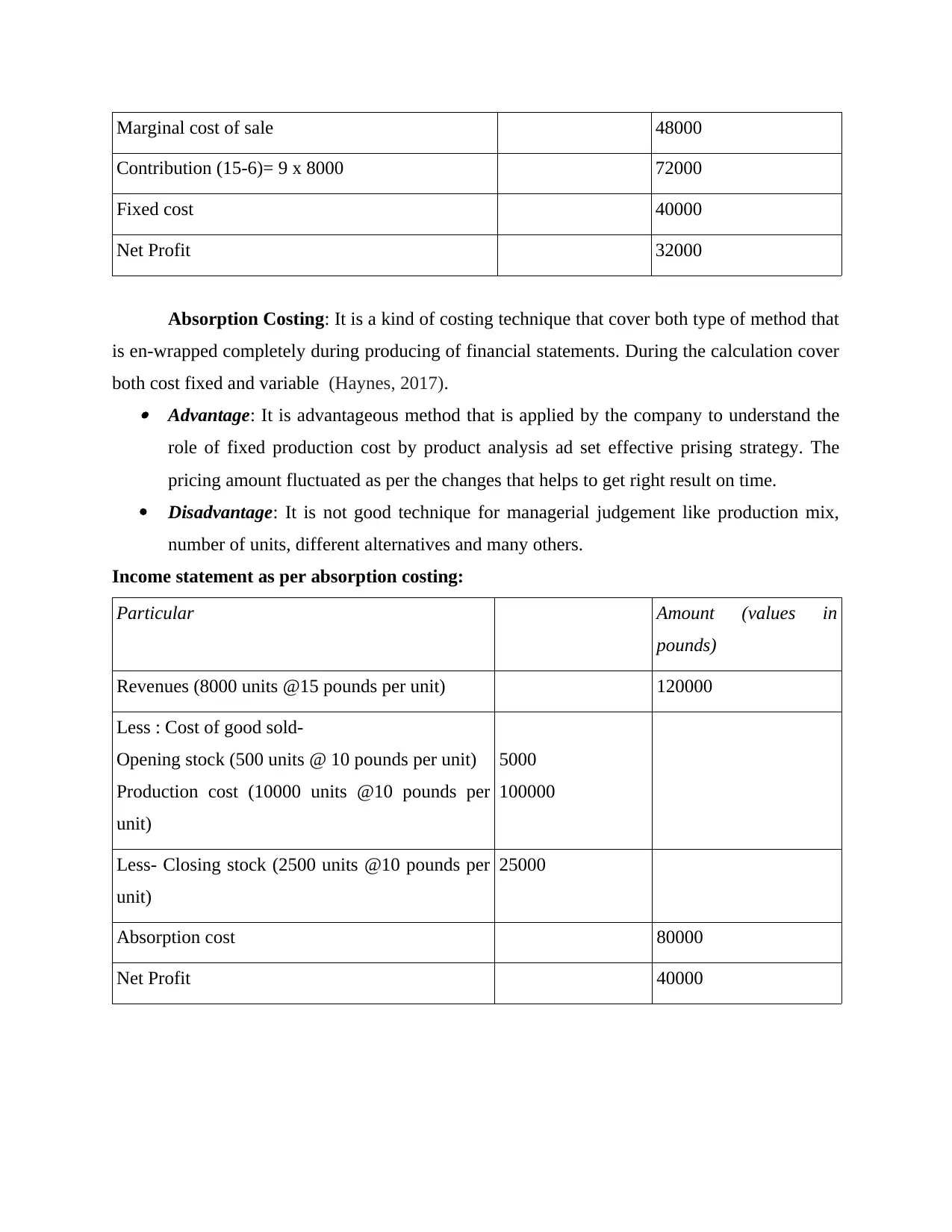
Marginal cost of sale 48000
Contribution (15-6)= 9 x 8000 72000
Fixed cost 40000
Net Profit 32000
Absorption Costing: It is a kind of costing technique that cover both type of method that
is en-wrapped completely during producing of financial statements. During the calculation cover
both cost fixed and variable (Haynes, 2017). Advantage: It is advantageous method that is applied by the company to understand the
role of fixed production cost by product analysis ad set effective prising strategy. The
pricing amount fluctuated as per the changes that helps to get right result on time.
Disadvantage: It is not good technique for managerial judgement like production mix,
number of units, different alternatives and many others.
Income statement as per absorption costing:
Particular Amount (values in
pounds)
Revenues (8000 units @15 pounds per unit) 120000
Less : Cost of good sold-
Opening stock (500 units @ 10 pounds per unit)
Production cost (10000 units @10 pounds per
unit)
5000
100000
Less- Closing stock (2500 units @10 pounds per
unit)
25000
Absorption cost 80000
Net Profit 40000
Contribution (15-6)= 9 x 8000 72000
Fixed cost 40000
Net Profit 32000
Absorption Costing: It is a kind of costing technique that cover both type of method that
is en-wrapped completely during producing of financial statements. During the calculation cover
both cost fixed and variable (Haynes, 2017). Advantage: It is advantageous method that is applied by the company to understand the
role of fixed production cost by product analysis ad set effective prising strategy. The
pricing amount fluctuated as per the changes that helps to get right result on time.
Disadvantage: It is not good technique for managerial judgement like production mix,
number of units, different alternatives and many others.
Income statement as per absorption costing:
Particular Amount (values in
pounds)
Revenues (8000 units @15 pounds per unit) 120000
Less : Cost of good sold-
Opening stock (500 units @ 10 pounds per unit)
Production cost (10000 units @10 pounds per
unit)
5000
100000
Less- Closing stock (2500 units @10 pounds per
unit)
25000
Absorption cost 80000
Net Profit 40000
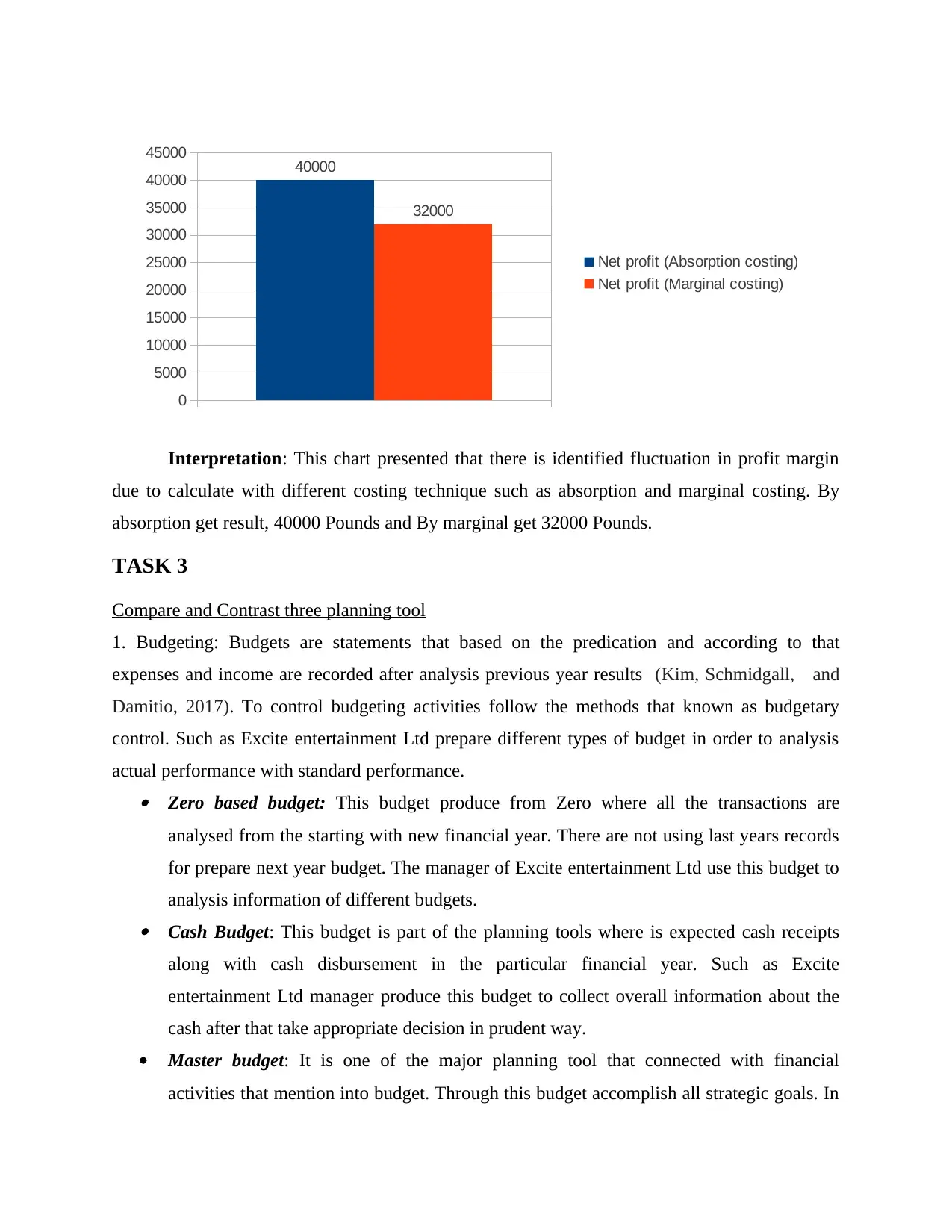
0
5000
10000
15000
20000
25000
30000
35000
40000
45000 40000
32000
Net profit (Absorption costing)
Net profit (Marginal costing)
Interpretation: This chart presented that there is identified fluctuation in profit margin
due to calculate with different costing technique such as absorption and marginal costing. By
absorption get result, 40000 Pounds and By marginal get 32000 Pounds.
TASK 3
Compare and Contrast three planning tool
1. Budgeting: Budgets are statements that based on the predication and according to that
expenses and income are recorded after analysis previous year results (Kim, Schmidgall, and
Damitio, 2017). To control budgeting activities follow the methods that known as budgetary
control. Such as Excite entertainment Ltd prepare different types of budget in order to analysis
actual performance with standard performance. Zero based budget: This budget produce from Zero where all the transactions are
analysed from the starting with new financial year. There are not using last years records
for prepare next year budget. The manager of Excite entertainment Ltd use this budget to
analysis information of different budgets. Cash Budget: This budget is part of the planning tools where is expected cash receipts
along with cash disbursement in the particular financial year. Such as Excite
entertainment Ltd manager produce this budget to collect overall information about the
cash after that take appropriate decision in prudent way.
Master budget: It is one of the major planning tool that connected with financial
activities that mention into budget. Through this budget accomplish all strategic goals. In
5000
10000
15000
20000
25000
30000
35000
40000
45000 40000
32000
Net profit (Absorption costing)
Net profit (Marginal costing)
Interpretation: This chart presented that there is identified fluctuation in profit margin
due to calculate with different costing technique such as absorption and marginal costing. By
absorption get result, 40000 Pounds and By marginal get 32000 Pounds.
TASK 3
Compare and Contrast three planning tool
1. Budgeting: Budgets are statements that based on the predication and according to that
expenses and income are recorded after analysis previous year results (Kim, Schmidgall, and
Damitio, 2017). To control budgeting activities follow the methods that known as budgetary
control. Such as Excite entertainment Ltd prepare different types of budget in order to analysis
actual performance with standard performance. Zero based budget: This budget produce from Zero where all the transactions are
analysed from the starting with new financial year. There are not using last years records
for prepare next year budget. The manager of Excite entertainment Ltd use this budget to
analysis information of different budgets. Cash Budget: This budget is part of the planning tools where is expected cash receipts
along with cash disbursement in the particular financial year. Such as Excite
entertainment Ltd manager produce this budget to collect overall information about the
cash after that take appropriate decision in prudent way.
Master budget: It is one of the major planning tool that connected with financial
activities that mention into budget. Through this budget accomplish all strategic goals. In
Secure Best Marks with AI Grader
Need help grading? Try our AI Grader for instant feedback on your assignments.
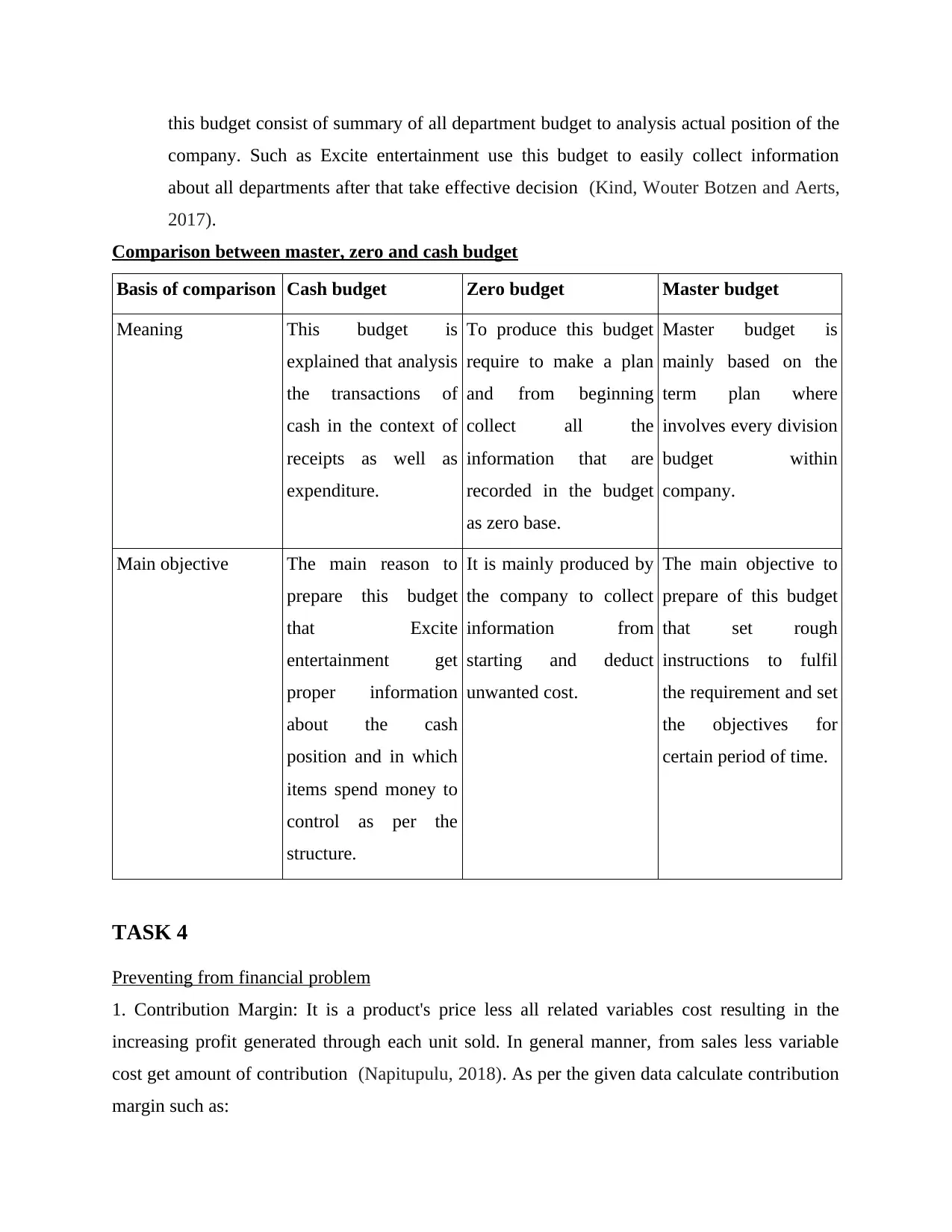
this budget consist of summary of all department budget to analysis actual position of the
company. Such as Excite entertainment use this budget to easily collect information
about all departments after that take effective decision (Kind, Wouter Botzen and Aerts,
2017).
Comparison between master, zero and cash budget
Basis of comparison Cash budget Zero budget Master budget
Meaning This budget is
explained that analysis
the transactions of
cash in the context of
receipts as well as
expenditure.
To produce this budget
require to make a plan
and from beginning
collect all the
information that are
recorded in the budget
as zero base.
Master budget is
mainly based on the
term plan where
involves every division
budget within
company.
Main objective The main reason to
prepare this budget
that Excite
entertainment get
proper information
about the cash
position and in which
items spend money to
control as per the
structure.
It is mainly produced by
the company to collect
information from
starting and deduct
unwanted cost.
The main objective to
prepare of this budget
that set rough
instructions to fulfil
the requirement and set
the objectives for
certain period of time.
TASK 4
Preventing from financial problem
1. Contribution Margin: It is a product's price less all related variables cost resulting in the
increasing profit generated through each unit sold. In general manner, from sales less variable
cost get amount of contribution (Napitupulu, 2018). As per the given data calculate contribution
margin such as:
company. Such as Excite entertainment use this budget to easily collect information
about all departments after that take effective decision (Kind, Wouter Botzen and Aerts,
2017).
Comparison between master, zero and cash budget
Basis of comparison Cash budget Zero budget Master budget
Meaning This budget is
explained that analysis
the transactions of
cash in the context of
receipts as well as
expenditure.
To produce this budget
require to make a plan
and from beginning
collect all the
information that are
recorded in the budget
as zero base.
Master budget is
mainly based on the
term plan where
involves every division
budget within
company.
Main objective The main reason to
prepare this budget
that Excite
entertainment get
proper information
about the cash
position and in which
items spend money to
control as per the
structure.
It is mainly produced by
the company to collect
information from
starting and deduct
unwanted cost.
The main objective to
prepare of this budget
that set rough
instructions to fulfil
the requirement and set
the objectives for
certain period of time.
TASK 4
Preventing from financial problem
1. Contribution Margin: It is a product's price less all related variables cost resulting in the
increasing profit generated through each unit sold. In general manner, from sales less variable
cost get amount of contribution (Napitupulu, 2018). As per the given data calculate contribution
margin such as:
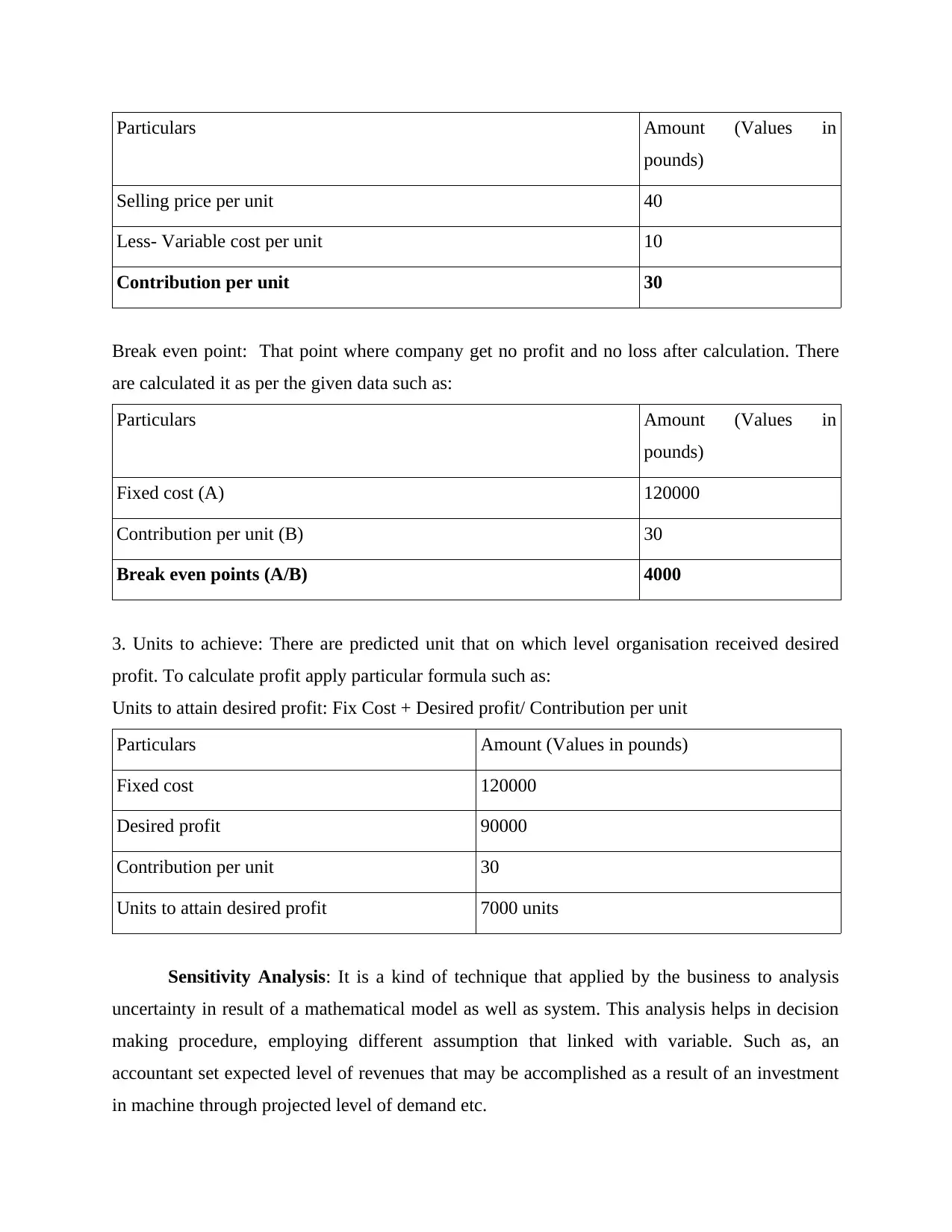
Particulars Amount (Values in
pounds)
Selling price per unit 40
Less- Variable cost per unit 10
Contribution per unit 30
Break even point: That point where company get no profit and no loss after calculation. There
are calculated it as per the given data such as:
Particulars Amount (Values in
pounds)
Fixed cost (A) 120000
Contribution per unit (B) 30
Break even points (A/B) 4000
3. Units to achieve: There are predicted unit that on which level organisation received desired
profit. To calculate profit apply particular formula such as:
Units to attain desired profit: Fix Cost + Desired profit/ Contribution per unit
Particulars Amount (Values in pounds)
Fixed cost 120000
Desired profit 90000
Contribution per unit 30
Units to attain desired profit 7000 units
Sensitivity Analysis: It is a kind of technique that applied by the business to analysis
uncertainty in result of a mathematical model as well as system. This analysis helps in decision
making procedure, employing different assumption that linked with variable. Such as, an
accountant set expected level of revenues that may be accomplished as a result of an investment
in machine through projected level of demand etc.
pounds)
Selling price per unit 40
Less- Variable cost per unit 10
Contribution per unit 30
Break even point: That point where company get no profit and no loss after calculation. There
are calculated it as per the given data such as:
Particulars Amount (Values in
pounds)
Fixed cost (A) 120000
Contribution per unit (B) 30
Break even points (A/B) 4000
3. Units to achieve: There are predicted unit that on which level organisation received desired
profit. To calculate profit apply particular formula such as:
Units to attain desired profit: Fix Cost + Desired profit/ Contribution per unit
Particulars Amount (Values in pounds)
Fixed cost 120000
Desired profit 90000
Contribution per unit 30
Units to attain desired profit 7000 units
Sensitivity Analysis: It is a kind of technique that applied by the business to analysis
uncertainty in result of a mathematical model as well as system. This analysis helps in decision
making procedure, employing different assumption that linked with variable. Such as, an
accountant set expected level of revenues that may be accomplished as a result of an investment
in machine through projected level of demand etc.
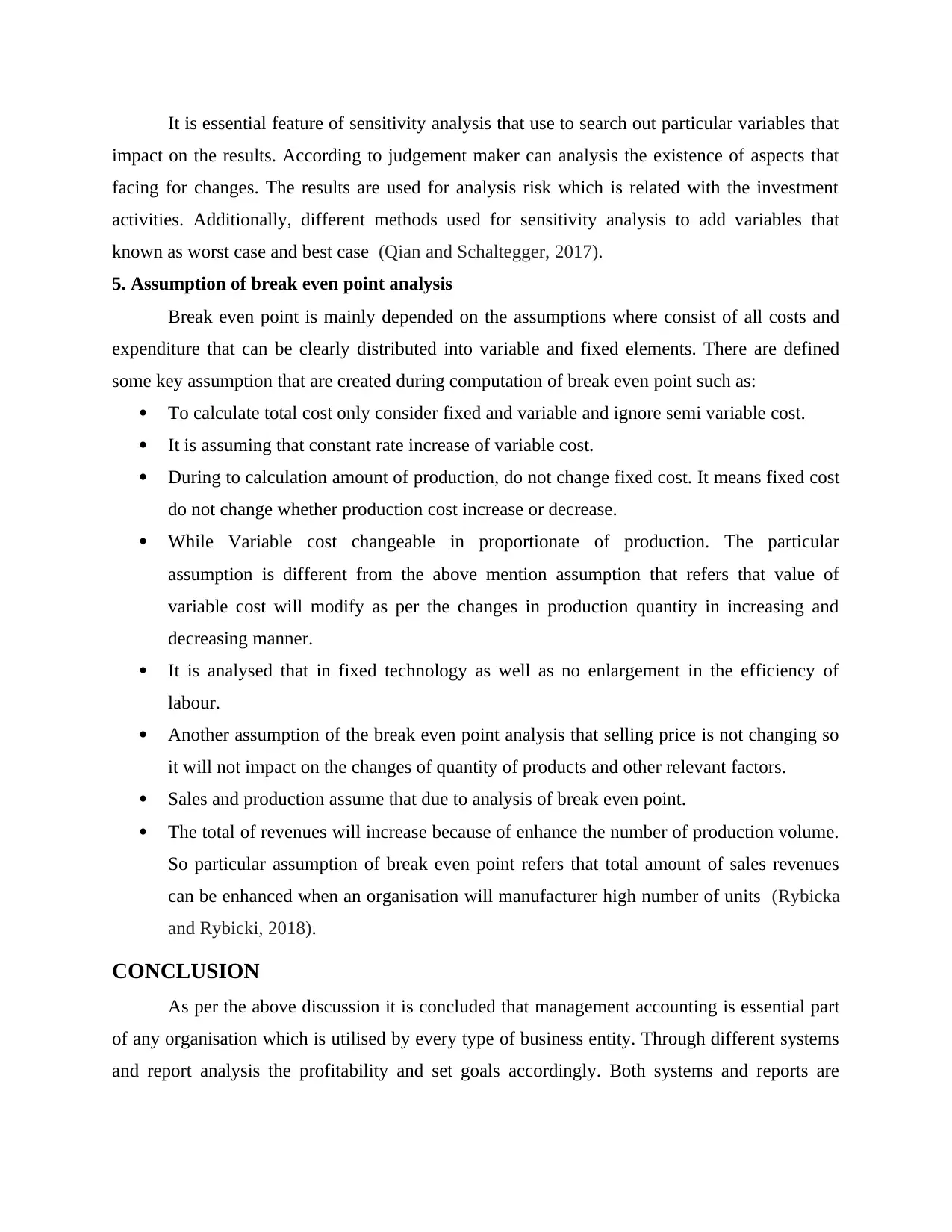
It is essential feature of sensitivity analysis that use to search out particular variables that
impact on the results. According to judgement maker can analysis the existence of aspects that
facing for changes. The results are used for analysis risk which is related with the investment
activities. Additionally, different methods used for sensitivity analysis to add variables that
known as worst case and best case (Qian and Schaltegger, 2017).
5. Assumption of break even point analysis
Break even point is mainly depended on the assumptions where consist of all costs and
expenditure that can be clearly distributed into variable and fixed elements. There are defined
some key assumption that are created during computation of break even point such as:
To calculate total cost only consider fixed and variable and ignore semi variable cost.
It is assuming that constant rate increase of variable cost.
During to calculation amount of production, do not change fixed cost. It means fixed cost
do not change whether production cost increase or decrease.
While Variable cost changeable in proportionate of production. The particular
assumption is different from the above mention assumption that refers that value of
variable cost will modify as per the changes in production quantity in increasing and
decreasing manner.
It is analysed that in fixed technology as well as no enlargement in the efficiency of
labour.
Another assumption of the break even point analysis that selling price is not changing so
it will not impact on the changes of quantity of products and other relevant factors.
Sales and production assume that due to analysis of break even point.
The total of revenues will increase because of enhance the number of production volume.
So particular assumption of break even point refers that total amount of sales revenues
can be enhanced when an organisation will manufacturer high number of units (Rybicka
and Rybicki, 2018).
CONCLUSION
As per the above discussion it is concluded that management accounting is essential part
of any organisation which is utilised by every type of business entity. Through different systems
and report analysis the profitability and set goals accordingly. Both systems and reports are
impact on the results. According to judgement maker can analysis the existence of aspects that
facing for changes. The results are used for analysis risk which is related with the investment
activities. Additionally, different methods used for sensitivity analysis to add variables that
known as worst case and best case (Qian and Schaltegger, 2017).
5. Assumption of break even point analysis
Break even point is mainly depended on the assumptions where consist of all costs and
expenditure that can be clearly distributed into variable and fixed elements. There are defined
some key assumption that are created during computation of break even point such as:
To calculate total cost only consider fixed and variable and ignore semi variable cost.
It is assuming that constant rate increase of variable cost.
During to calculation amount of production, do not change fixed cost. It means fixed cost
do not change whether production cost increase or decrease.
While Variable cost changeable in proportionate of production. The particular
assumption is different from the above mention assumption that refers that value of
variable cost will modify as per the changes in production quantity in increasing and
decreasing manner.
It is analysed that in fixed technology as well as no enlargement in the efficiency of
labour.
Another assumption of the break even point analysis that selling price is not changing so
it will not impact on the changes of quantity of products and other relevant factors.
Sales and production assume that due to analysis of break even point.
The total of revenues will increase because of enhance the number of production volume.
So particular assumption of break even point refers that total amount of sales revenues
can be enhanced when an organisation will manufacturer high number of units (Rybicka
and Rybicki, 2018).
CONCLUSION
As per the above discussion it is concluded that management accounting is essential part
of any organisation which is utilised by every type of business entity. Through different systems
and report analysis the profitability and set goals accordingly. Both systems and reports are
Paraphrase This Document
Need a fresh take? Get an instant paraphrase of this document with our AI Paraphraser
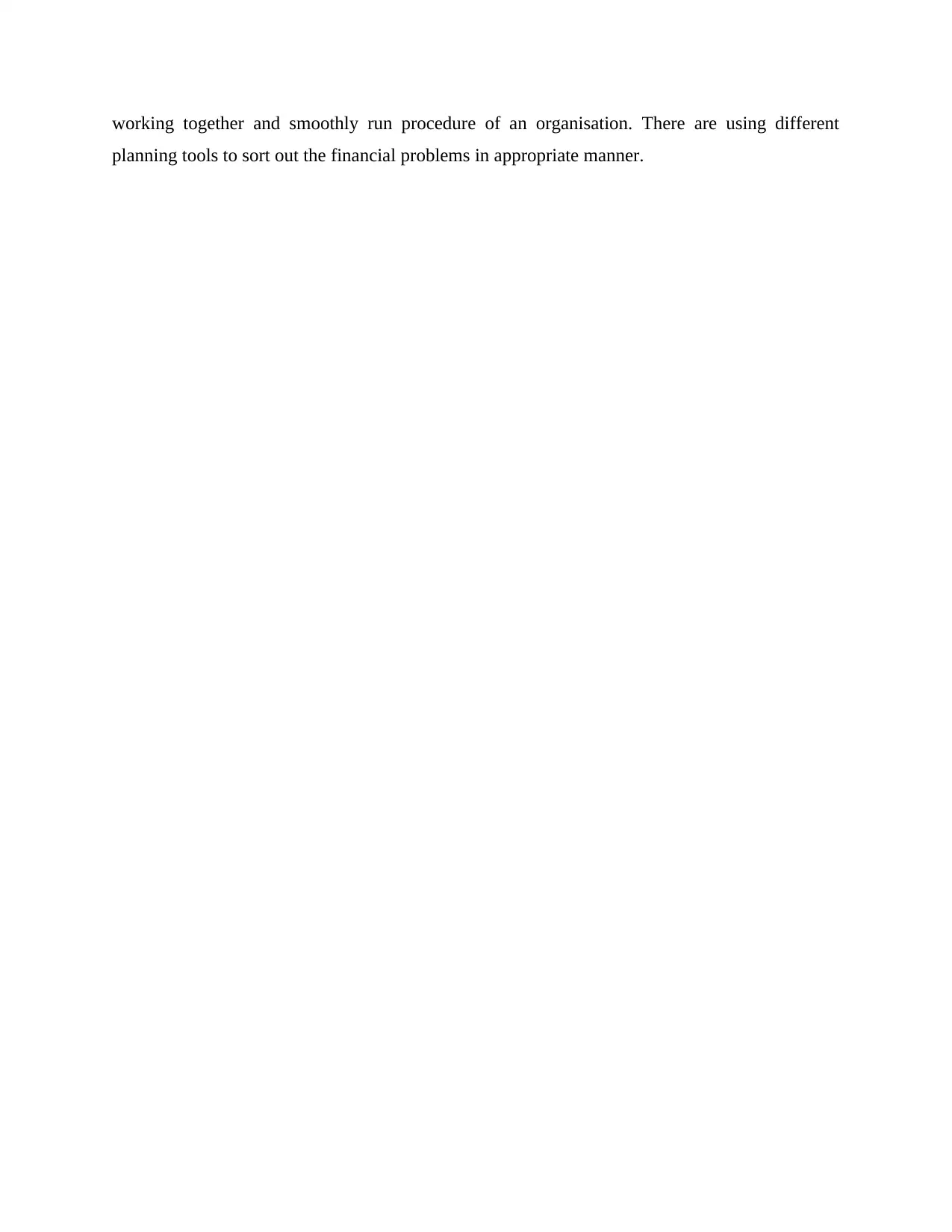
working together and smoothly run procedure of an organisation. There are using different
planning tools to sort out the financial problems in appropriate manner.
planning tools to sort out the financial problems in appropriate manner.
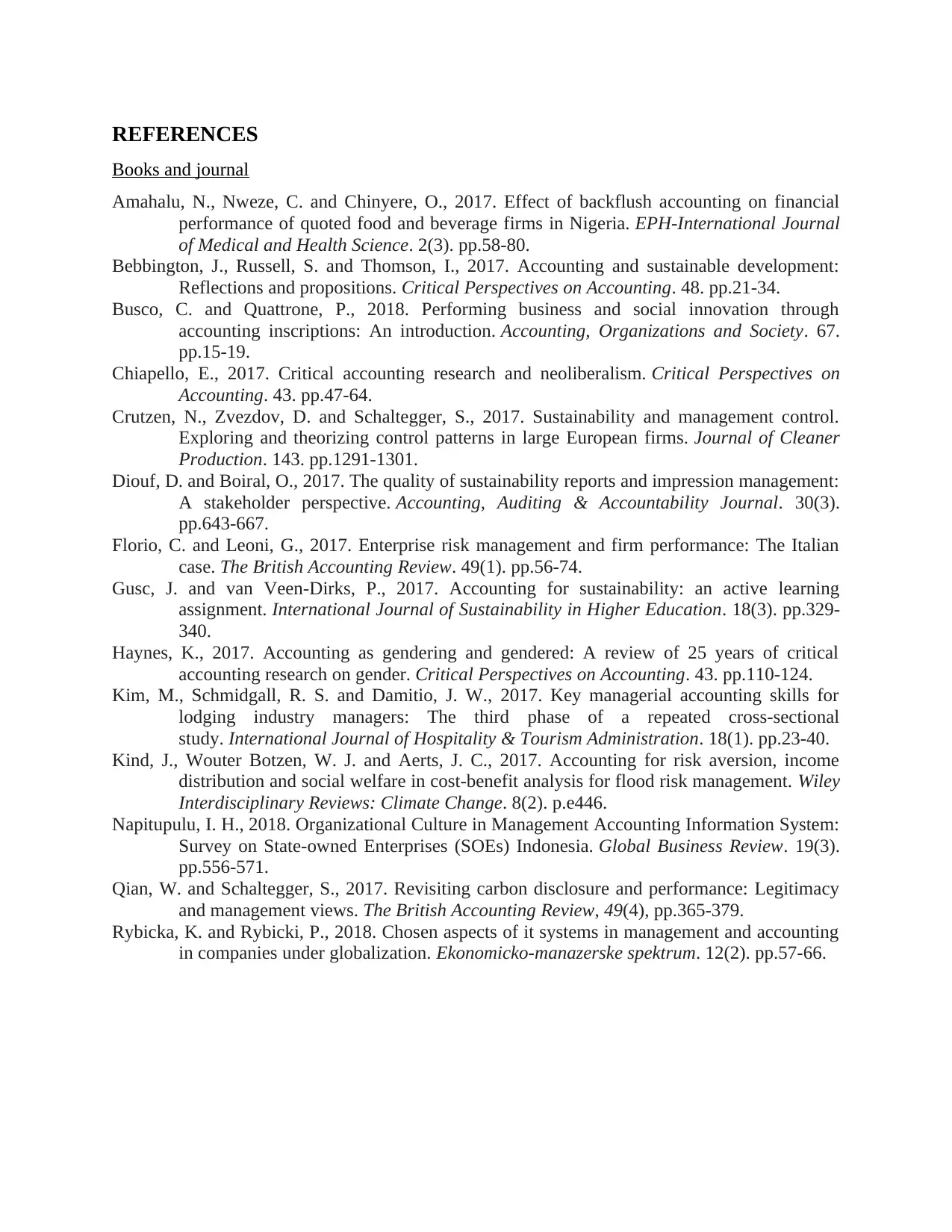
REFERENCES
Books and journal
Amahalu, N., Nweze, C. and Chinyere, O., 2017. Effect of backflush accounting on financial
performance of quoted food and beverage firms in Nigeria. EPH-International Journal
of Medical and Health Science. 2(3). pp.58-80.
Bebbington, J., Russell, S. and Thomson, I., 2017. Accounting and sustainable development:
Reflections and propositions. Critical Perspectives on Accounting. 48. pp.21-34.
Busco, C. and Quattrone, P., 2018. Performing business and social innovation through
accounting inscriptions: An introduction. Accounting, Organizations and Society. 67.
pp.15-19.
Chiapello, E., 2017. Critical accounting research and neoliberalism. Critical Perspectives on
Accounting. 43. pp.47-64.
Crutzen, N., Zvezdov, D. and Schaltegger, S., 2017. Sustainability and management control.
Exploring and theorizing control patterns in large European firms. Journal of Cleaner
Production. 143. pp.1291-1301.
Diouf, D. and Boiral, O., 2017. The quality of sustainability reports and impression management:
A stakeholder perspective. Accounting, Auditing & Accountability Journal. 30(3).
pp.643-667.
Florio, C. and Leoni, G., 2017. Enterprise risk management and firm performance: The Italian
case. The British Accounting Review. 49(1). pp.56-74.
Gusc, J. and van Veen-Dirks, P., 2017. Accounting for sustainability: an active learning
assignment. International Journal of Sustainability in Higher Education. 18(3). pp.329-
340.
Haynes, K., 2017. Accounting as gendering and gendered: A review of 25 years of critical
accounting research on gender. Critical Perspectives on Accounting. 43. pp.110-124.
Kim, M., Schmidgall, R. S. and Damitio, J. W., 2017. Key managerial accounting skills for
lodging industry managers: The third phase of a repeated cross-sectional
study. International Journal of Hospitality & Tourism Administration. 18(1). pp.23-40.
Kind, J., Wouter Botzen, W. J. and Aerts, J. C., 2017. Accounting for risk aversion, income
distribution and social welfare in cost‐benefit analysis for flood risk management. Wiley
Interdisciplinary Reviews: Climate Change. 8(2). p.e446.
Napitupulu, I. H., 2018. Organizational Culture in Management Accounting Information System:
Survey on State-owned Enterprises (SOEs) Indonesia. Global Business Review. 19(3).
pp.556-571.
Qian, W. and Schaltegger, S., 2017. Revisiting carbon disclosure and performance: Legitimacy
and management views. The British Accounting Review, 49(4), pp.365-379.
Rybicka, K. and Rybicki, P., 2018. Chosen aspects of it systems in management and accounting
in companies under globalization. Ekonomicko-manazerske spektrum. 12(2). pp.57-66.
Books and journal
Amahalu, N., Nweze, C. and Chinyere, O., 2017. Effect of backflush accounting on financial
performance of quoted food and beverage firms in Nigeria. EPH-International Journal
of Medical and Health Science. 2(3). pp.58-80.
Bebbington, J., Russell, S. and Thomson, I., 2017. Accounting and sustainable development:
Reflections and propositions. Critical Perspectives on Accounting. 48. pp.21-34.
Busco, C. and Quattrone, P., 2018. Performing business and social innovation through
accounting inscriptions: An introduction. Accounting, Organizations and Society. 67.
pp.15-19.
Chiapello, E., 2017. Critical accounting research and neoliberalism. Critical Perspectives on
Accounting. 43. pp.47-64.
Crutzen, N., Zvezdov, D. and Schaltegger, S., 2017. Sustainability and management control.
Exploring and theorizing control patterns in large European firms. Journal of Cleaner
Production. 143. pp.1291-1301.
Diouf, D. and Boiral, O., 2017. The quality of sustainability reports and impression management:
A stakeholder perspective. Accounting, Auditing & Accountability Journal. 30(3).
pp.643-667.
Florio, C. and Leoni, G., 2017. Enterprise risk management and firm performance: The Italian
case. The British Accounting Review. 49(1). pp.56-74.
Gusc, J. and van Veen-Dirks, P., 2017. Accounting for sustainability: an active learning
assignment. International Journal of Sustainability in Higher Education. 18(3). pp.329-
340.
Haynes, K., 2017. Accounting as gendering and gendered: A review of 25 years of critical
accounting research on gender. Critical Perspectives on Accounting. 43. pp.110-124.
Kim, M., Schmidgall, R. S. and Damitio, J. W., 2017. Key managerial accounting skills for
lodging industry managers: The third phase of a repeated cross-sectional
study. International Journal of Hospitality & Tourism Administration. 18(1). pp.23-40.
Kind, J., Wouter Botzen, W. J. and Aerts, J. C., 2017. Accounting for risk aversion, income
distribution and social welfare in cost‐benefit analysis for flood risk management. Wiley
Interdisciplinary Reviews: Climate Change. 8(2). p.e446.
Napitupulu, I. H., 2018. Organizational Culture in Management Accounting Information System:
Survey on State-owned Enterprises (SOEs) Indonesia. Global Business Review. 19(3).
pp.556-571.
Qian, W. and Schaltegger, S., 2017. Revisiting carbon disclosure and performance: Legitimacy
and management views. The British Accounting Review, 49(4), pp.365-379.
Rybicka, K. and Rybicki, P., 2018. Chosen aspects of it systems in management and accounting
in companies under globalization. Ekonomicko-manazerske spektrum. 12(2). pp.57-66.
1 out of 15
Related Documents
Your All-in-One AI-Powered Toolkit for Academic Success.
+13062052269
info@desklib.com
Available 24*7 on WhatsApp / Email
![[object Object]](/_next/static/media/star-bottom.7253800d.svg)
Unlock your academic potential
© 2024 | Zucol Services PVT LTD | All rights reserved.





